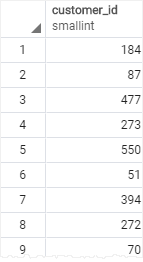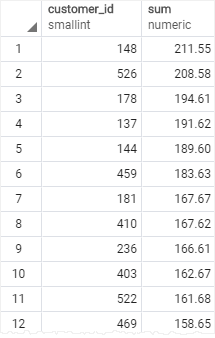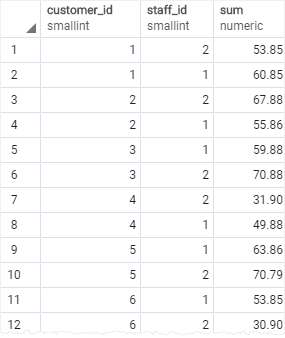August 1, 2023
Summary: in this tutorial, you will learn how to divide rows into groups by using the PostgreSQL GROUP BY clause.
Table of Contents
Introduction to PostgreSQL GROUP BY clause
The GROUP BY clause divides the rows returned from the SELECT statement into groups. For each group, you can apply an aggregate function e.g., SUM() to calculate the sum of items or COUNT() to get the number of items in the groups.
The following statement illustrates the basic syntax of the GROUP BY clause:
SELECT
column_1,
column_2,
...,
aggregate_function(column_3)
FROM
table_name
GROUP BY
column_1,
column_2,
...;
In this syntax:
- First, select the columns that you want to group e.g.,
column1andcolumn2, and column that you want to apply an aggregate function (column3). - Second, list the columns that you want to group in the
GROUP BYclause.
The statement clause divides the rows by the values of the columns specified in the GROUP BY clause and calculates a value for each group.
It’s possible to use other clauses of the SELECT statement with the GROUP BY clause.
PostgreSQL evaluates the GROUP BY clause after the FROM and WHERE clauses and before the HAVING SELECT, DISTINCT, ORDER BY and LIMIT clauses.

PostgreSQL GROUP BY clause examples
Let’s take a look at the payment table in the sample database.

1) Using PostgreSQL GROUP BY without an aggregate function example
You can use the GROUP BY clause without applying an aggregate function. The following query gets data from the payment table and groups the result by customer id.
SELECT
customer_id
FROM
payment
GROUP BY
customer_id;

In this case, the GROUP BY works like the DISTINCT clause that removes duplicate rows from the result set.
2) Using PostgreSQL GROUP BY with SUM() function example
The GROUP BY clause is useful when it is used in conjunction with an aggregate function.
For example, to select the total amount that each customer has been paid, you use the GROUP BY clause to divide the rows in the payment table into groups grouped by customer id. For each group, you calculate the total amounts using the SUM() function.
The following query uses the GROUP BY clause to get the total amount that each customer has been paid:
SELECT
customer_id,
SUM (amount)
FROM
payment
GROUP BY
customer_id;

The GROUP BY clause sorts the result set by customer id and adds up the amount that belongs to the same customer. Whenever the customer_id changes, it adds the row to the returned result set.
The following statement uses the ORDER BY clause with GROUP BY clause to sort the groups:
SELECT
customer_id,
SUM (amount)
FROM
payment
GROUP BY
customer_id
ORDER BY
SUM (amount) DESC;

3) Using PostgreSQL GROUP BY clause with the JOIN clause
The following statement uses the GROUP BY clause with the INNER JOIN clause the get the total amount paid by each customer.
Unlike the previous example, this query joins the payment table with the customer table and group customers by their names.
SELECT
first_name || ' ' || last_name full_name,
SUM (amount) amount
FROM
payment
INNER JOIN customer USING (customer_id)
GROUP BY
full_name
ORDER BY amount DESC;

4) Using PostgreSQL GROUP BY with COUNT() function example
To find the number of payment transactions that each staff has processed, you group the rows in the payment table by the values in the staff_id column and use the COUNT() function to get the number of transactions:
SELECT
staff_id,
COUNT (payment_id)
FROM
payment
GROUP BY
staff_id;

The GROUP BY clause divides the rows in the payment into groups and groups them by value in the staff_id column. For each group, it returns the number of rows by using the COUNT() function.
5) Using PostgreSQL GROUP BY with multiple columns
The following example uses multiple columns in the GROUP BY clause:
SELECT
customer_id,
staff_id,
SUM(amount)
FROM
payment
GROUP BY
staff_id,
customer_id
ORDER BY
customer_id;
In this example, the GROUP BY clause divides the rows in the payment table by the values in the customer_id and staff_id columns. For each group of (customer_id, staff_id), the SUM() calculates the total amount.

6) Using PostgreSQL GROUP BY clause with a date column
The payment_date is a timestamp column. To group payments by dates, you use the DATE() function to convert timestamps to dates first and then group payments by the result date:
SELECT
DATE(payment_date) paid_date,
SUM(amount) sum
FROM
payment
GROUP BY
DATE(payment_date);

In this tutorial, you have learned how to use the PostgreSQL GROUP BY clause to divide rows into groups and apply an aggregate function to each group.

